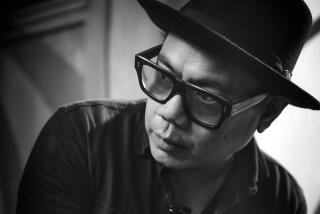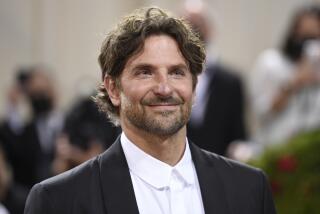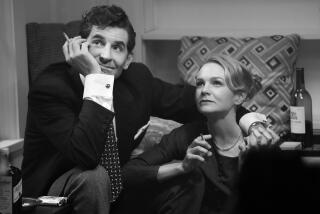From the Archives: Gary Cooper Dies of Cancer at 60
Gary Cooper, the strong, silent hero of the screen, died of cancer at 12:27 p.m. Saturday in the quiet of his Holmby Hills home.
The 60-year-old actor’s death, awaited by his family and friends and by Cooper himself for two weeks, ended a long fight with the disease, the nature of which did not become publicly known until his confinement last month.
The tall, drawling Cooper, winner of two Academy Awards in a film career that spanned 35 years, had received messages of hope from all over the world, including a call from President Kennedy.
Family at Side
Cooper’s wife, Veronica, their daughter, Maria, the family doctor, a priest and two male nurses were with Cooper when the end came in a bedroom of his estate at 200 Baroda Dr.
Fears for the actor’s health arose a year ago after a prostate operation. He denied then that there was a malignancy. Five weeks later, a cancerous portion of his colon was removed, but he still wouldn’t admit it.
From then on, doctors acknowledged later, it was only a matter of time.
Cooper, heavily drugged for the last 10 days to ease the intense pain, received the last rites of the Catholic Church on Friday.
A long-time friend, the Rt. Rev. Daniel Sullivan of the Church of the Good Shepherd, Beverly Hills, said he was able to talk with Cooper briefly on Thursday.
Catholic Convert
“Although he was weak, I was amazed how alert he was,” Father Sullivan commented.
The priest reported that Cooper had been unconscious all day and died while sleeping peacefully under sedation.
He said the wife and daughter took the death calmly. And he disclosed that Mrs. Cooper had known since December that her husband’s illness was incurable.
Cooper, reared as an Episcopalian, was converted in 1959 to Catholicism, the faith of his wife and daughter.
He had received no visitors for two weeks, and his family remained constantly at his bedside.
Wasted by Disease
The actor’s physician, Dr. Rexford Kennamer, marvelled that Cooper, his big frame wasted by the disease, had clung to life as long as he did.
“Any other man would have died 48 hours ago,” the doctor said.
Gary Cooper, Hollywood’s homespun hero, was another product of its big star era—the same era in which names like Clark Gable, John Wayne, Errol Flynn and Tyrone Power became household words to millions.
It was an era which Hollywood itself believes is gone forever.
Cooper brought to the screen a personality that was all his own. His taciturn drawl, shy grin and the loose-jointed way he carried his 6 ft. 3 in. frame came to typify something as American as buckwheat cakes.
Moreover, he was Hollywood’s own creation. He came here almost directly from a ranch near Helena, Mont., his birthplace, rather than by way of the stage, radio or other entertainment media.
Aspired to Be Artist
The son of a state supreme court justice, Cooper originally aspired to be an artist and from 1922 to 1924 he studied art at Grinnell College in Iowa. But in Los Angeles he found he could make more money as a screen extra and stunt man.
He was introduced to many Hollywood figures by Grace Kingsley, a film society columnist for the Los Angeles Times. Cooper accompanied her on some assignments. But the film colony was unimpressed.
“He’s too bashful,” was the usual comment.
Cooper acquired an agent, Nan Collins, then a casting director as United Studios. It was Miss Collins who suggest he change his real name from Frank James Cooper to Gary Cooper. The new name clicked.
Tabbed by Goldwyn
In 1925 an independent producer, Hans Tiesler, cast Cooper opposite Eileen Sedgewick in a two-reeler. After a dozen or more such short subjects, Samuel Goldwyn finally picked Cooper for a part in “The Winning of Barbara Worth,” starring Ronald Colman and Vilma Banky.
Then Paramount signed him to a long term contract, and Cooper was on his way to stardom. For 11 years he was one of Hollywood’s highest paid performers.
Of 75 major pictures, his most memorable roles were as “Sergeant York,” in 1941, and as the frontier marshal in “High Noon,” in 1952. He won the Academy Award for each.
He was nominated also for his performances in “Mr. Deeds Goes to Town” (1936), “Pride of the Yankees” (1942) and “For Whom the Bell Tolls” (1943).
Fame and Ulcers
Long hours in the studios brought Cooper fame and fortune and also ulcers. One year his weight fell to 146 lbs. In 1931 he quit cold and went big game hunting in Africa and, as he told it afterward, “learned to relax.”
In later years, Cooper’s easy-going manner became more than a characteristic. It was a way of life.
He enjoyed playing tennis and skin diving in the Pacific, not far from his home. “Old Coop,” as friends have called him almost since boyhood, also liked to wear old clothes and could fall asleep anywhere.
Had One Daughter
In 1933 he married Veronica Balfe, whom he nicknamed “Rocky.” She bore him one daughter, Maria, now 23.
Cooper loved to hunt and fish and was an outdoorsman throughout his life. Among his close friends were James Stewart, Fred MacMurray, Joel McCrea, Ernest Hemingway and the late Clark Gable.
His love for the outdoors went back to youthful years on his father’s Montana ranch.
But Cooper was no ordinary range hand. His background essentially was of city life—plus a four year stint at Dunstabel School in England. In fact he spoke with an English accent upon his return to Helena at 13.
He learned to ride and handle cattle as a teenager. During World War I he quit school, moved to the ranch and ran a 500-head herd.
In many respects, the real life Cooper was not very different from the moviegoer’s image of him. It could safely be said that Gary Cooper as himself was one of the most enduring symbols created by the motion picture.
He never seemed to want people to realize that he was a highly skilled, high-priced actor who could really act. His profession earned him at least $10 million. In 1939 he was the nation’s highest paid wage earner at $482,819. He drove a Bentley, owned three homes and an art collection and headed his own production company (Baroda).
Cooper’s durability was all the more remarkable in terms of the physical stresses he withstood over the years.
As a boy in Montana he broke a hip in an automobile accident. The hip healed imperfectly and contributed to the Gary Cooper walk—a vaguely bow-legged, slow-rolling gait that made him seem like a cowboy even in a business suit.
By coincidence, Cooper was the same age as “The Virginian,” the novel which Owen Wister started writing in 1901. Cooper was born on May 7 that year. The book was published in 1902 and made into Cooper’s first talking picture in 1929.
Cooper credited the film with establishing his career. In his words:
“That was the big one. You had to survive the transition to talking pictures. ‘The Virginian’ put me over the hump and made millions.”
From the Archives: Marlene Dietrich, Classic Femme Fatale, Dies at 90
From the Archives: Screen Idol Douglas Fairbanks Jr. Dies at 90
From the Archives: Bette Davis Dies in Paris at 81
From the Archives: Gloria Swanson, Queen of Movies’ Golden Years, Dies
From the Archives: ‘America Lost a National Treasure’
More to Read
Start your day right
Sign up for Essential California for the L.A. Times biggest news, features and recommendations in your inbox six days a week.
You may occasionally receive promotional content from the Los Angeles Times.






